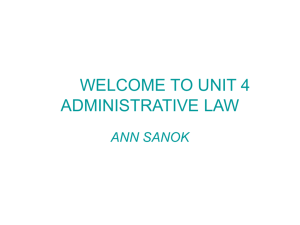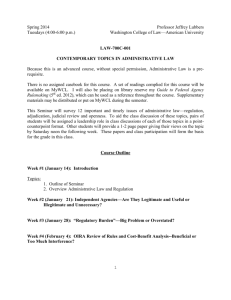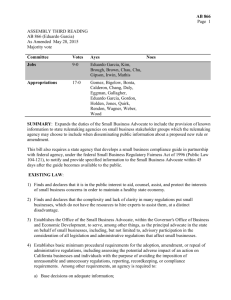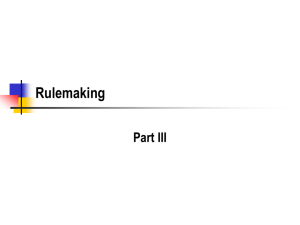Chap. 8: Ambiguities in Rulemaking
advertisement
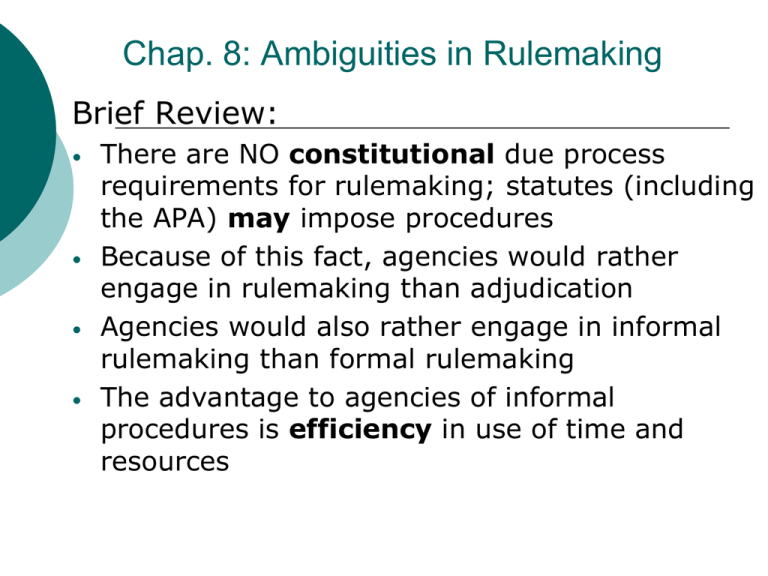
Chap. 8: Ambiguities in Rulemaking Brief Review: • • • • There are NO constitutional due process requirements for rulemaking; statutes (including the APA) may impose procedures Because of this fact, agencies would rather engage in rulemaking than adjudication Agencies would also rather engage in informal rulemaking than formal rulemaking The advantage to agencies of informal procedures is efficiency in use of time and resources Administrative law is an attempt to impose the rule of law on the administrative state, which inevitably restricts/restrains the efficient operation of administration Administrative law is therefore fundamentally at odds with the ideal of the administrative state Administrative law, by imposing procedures in the name of promoting rationality, fairness, etc. sacrifices some level of efficiency to achieve another desirable objective Efficiency=informality Rationality = formality The Case for Informal Rulemaking Prof. Kenneth C. Davis, best known and most widely respected admin. law scholar, believes that informal rulemaking is “perhaps one of the greatest inventions of modern government.” The whole purpose of the administrative state would be thwarted if agencies could not make rules informally, as through the “notice & comment” feature of §553 of the APA The Case for Informal Rulemaking Agencies can gather and examine any info they wish from any source Any one is able to submit evidence Decisions are not limited to info generated by parties on the record of a hearing Speedy decision making Decisions are fairer than trial-type proceedings because no fault is assigned for past behavior, no costly legal battles required to defend anyone from sanctions; looks only forward toward future compliance rather than backward to punish wrongdoing The parallel between legislating (statutory law) and rulemaking (regulatory law) Congress doesn’t have to have formal hearings with Goldberg ingredients when it legislates Therefore, agencies shouldn’t have to have them either when they make rules (which is the equivalent of generating statutes) HOWEVER The parallel breaks down when you consider the following points: The Constitution does impose two very important procedures on Congress Bicameralism Presentment Congressmen are elected; agency personnel are not The Senate provides equal representation for our diverse states; there is nothing equivalent in the functioning of the administrative state Congress has bound itself with more formalized procedures at the committee level when hearings are conducted pursuant to enacting legislation The Case for Formality in Rulemaking Since agencies are undemocratically constituted and provide no recognition of the federal nature of our national government, perhaps it would be wise to impose greater limits on their discretionary power through procedural mechanisms when they make national rules that bind us all. U.S. v FL. East Coast Railway (1973) The ICC’s challenged rule? A prohibitively high tax (rate) on leased boxcars Rationale? Want to encourage purchase, not lease, of boxcars to combat shortage of boxcars in U.S. rail fleet It will be cheaper for RRs to purchase boxcars than to pay the newly-imposed tax on leased ones ICC has opted for the “stick” approach over the “carrot” approach for achieving goal The ICC adopted this rule after §553 “noticecomment” procedures However, the ICC’s historical practice had been to make rules more formally Its authorizing legislation requires it to make rules “after hearing” RR’s claim? ICC’s procedure violates APA and general common law principles of admin. law—when a statute says rules can only be made “after hearing,” that means a formal trial-type hearing must be provided; notice/comment isn’t enough Why didn’t RR raise a constitutional due process issue? What does the APA require when agency’s statute requires rulemaking “after a hearing”? Is there a difference between statutory language “after a hearing” and “after a hearing on the record”? Court revisits distinction between the nature of rulemaking and the nature of adjudication and reaffirms that the former can be more informal than the latter Dissent’s point? Evolution of Admin. Common Law on Rulemaking From the late 1950s to the mid-’70s several district & circuit courts moved to restrict agency rulemaking power (as noted in the previous case) by requiring more formality than APA §553 allowed, but stopping short of the formality of APA §554-557 hearings Thus emerged something called “hybrid rulemaking” which required agencies at least to have to develop an evidentiary basis for their rules The Court struck down this requirement in the following case, anticipated by the previous one Vermont Yankee NPC v NRDC (1978) Atomic Energy Commission (now called the Nuclear Regulatory Commission) grants licenses to nuclear power plants after they meet certain rules assuring safe operation When Vermont Yankee applied for a license it had no plan for long-term disposal of the waste it would generate AEC granted a license, then issued a “rule” that failure to specify a plan for waste disposal would not, alone, prevent issuance of a license The rule was adopted pursuant to §553 of the APA, although the agency did include oral argument and AEC questioning (but not cross-examination) of witnesses Natural Resources Defense Council sued claiming that const. due process required more than those procedures because of the technical nature of the evidence and the fact that it is “an issue of great public import” even though the AEC’s statute did not require a “hearing on the record” The lower courts agreed, thus endorsing a constitutional requirement for “hybrid rulemaking” and for all practical purposes overturning §553 of the APA Court overruled lower courts and put an end to the era of “hybrid rulemaking” common law development The Const. doesn’t require due process in rulemaking If the Bi-Metallic criteria for distinguishing adjudication from rulemaking are present, the Const. would require more than §553 The Court will look past the terminology used by an agency to the substance of its actions, so when “rulemaking” really partakes of the qualities of “adjudication,” more than §553 will be required, but only when that is the case. That was not the case in the present instance What About “Deregulatory” Rulemaking? Since more formality = more fairness, wouldn’t those opposed to the “administrative state” favor stricter admin. law as a way of hampering agency rulemaking? But what if agency rulemaking is being used to accomplish “deregulation” objectives? Strengthening admin. law (procedural formality) then could hamper the process of deregulation Motor Vehicles Manuf. Assoc. v State Farm (1983) NHTSA adopted rule in 1977 requiring “passive” safety system (either airbags or seatbelts) in all cars manufactured after Sept., 1982 By 1981 it was clear that almost all new cars had seatbelts, rather than expected 60%-40% split Reagan’s new NHTSA head then rescinded the rule before its effective date Safety benefits of airbags would not be realized Automatic seatbelts too easily disabled Thus, no real safety benefits accrue BUT c. $1 billion cost to consumers from implementation of rule would depress auto sales and poison public’s attitude toward safety regs in general State Farm sued to prohibit application of the new rule (rescinding the original rule) and to compel the application of the original rule The new rule, as was the case with the original rule, was made under APA §553 No allegations of procedural irregularities or agency excess of statutory authority Rather, claim of “arbitrary & capricious” rulemaking (revoking rule w/o justification and in way as to thwart congressional intent) Agency’s authorizing statute provides for judicial review of agency “action” Court holds “action” to include “revoking” a regulation as well as imposing one Court’s ruling: Agency action is “arbitrary and capricious” which is prohibited by §706(2)(A) of the APA What constitutes “a/c” action? No rational relationship between facts found and choice made Agency relied on factors Congress didn’t want considered Agency ignored important aspects of the problems it’s charged with addressing What made NHTSA’s action “a/c”? Didn’t explain why rule couldn’t require air bags agency’s lawyers supplied this ex post facto rationale in brief but there was no evidence that the agency had relied on this line of reasoning in its decisionmaking process Agency didn’t explain why it couldn’t require some kind of non-detachable automatic seat belt Agency rejected statistical evidence it had before it as invalid but didn’t conduct alternative studies to resolve uncertainties over the impact that the original rule would have on seat belt use Note: this case came a year BEFORE the Chevron case covered in Ch. 4
